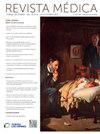Amiloidosis de cadenas ligeras con afectación cardíaca y gastrointestinal en un paciente adulto mayor: reporte de un caso clínico
IF 0.2
Q4 MEDICINE, GENERAL & INTERNAL
引用次数: 0
Abstract
Introduction
Light chain amyloidosis (AL) is a rare condition characterized by multisystem involvement. Due to the non-specific nature of its symptoms, there is often a significant delay between the onset of symptoms and a definitive diagnosis. Here, we present the case of a patient with predominant gastrointestinal and cardiac involvement.
Case report
A previously healthy 64-year-old female presented with a six-month history of asthenia, 15 kg weight loss with preserved appetite and chronic diarrhea. Upper endoscopy revealed erosive gastropathy and villous atrophy, later confirmed as systemic amyloidosis by duodenal biopsy with positive Congo Red staining. The patient developed pleuritic pain and pleural effusion, leading to a diagnosis of pneumonia. Cardiac studies revealed amyloid cardiomyopathy. Stage III amyloidosis AL with lambda light chains was diagnosed. During her hospitalization, the patient required a pacemaker due to cardiac rhythm disturbances and began chemotherapy with the CyBorD regimen, with good clinical response. She is currently receiving outpatient treatment, with good tolerance to the second cycle of chemotherapy.
Discussion
In our patient, the diagnosis of amyloidosis AL was primarily based on histological findings in the gastrointestinal tract. Of note was the rapid cardiac involvement, making it challenging to optimize pharmacological treatment. We highlight this case due to the rarity of the disease and the significant therapeutic challenges it presents.
老年患者中发生心脏和胃肠道疾病的轻链淀粉样变:临床病例报告
轻链淀粉样变性(AL)是一种罕见的多系统累及的疾病。由于其症状的非特异性,在症状发作和最终诊断之间往往有明显的延迟。在这里,我们提出的情况下,病人主要胃肠道和心脏受累。病例报告:既往健康的64岁女性,有6个月的虚弱史,体重减轻15公斤,保持食欲和慢性腹泻。上镜检查显示糜烂性胃病和绒毛萎缩,后经十二指肠活检证实为全身性淀粉样变性,刚果红染色阳性。患者出现胸膜疼痛和胸腔积液,诊断为肺炎。心脏检查显示淀粉样心肌病。诊断为伴有λ轻链的III期AL淀粉样变性。住院期间,患者因心律紊乱需要使用起搏器,并开始CyBorD方案化疗,临床反应良好。目前正在门诊治疗,对第二周期化疗耐受性良好。本例患者淀粉样变性AL的诊断主要基于胃肠道的组织学表现。值得注意的是心脏的快速受累,使得优化药物治疗具有挑战性。我们强调这种情况下,由于罕见的疾病和显著的治疗挑战,它提出。
本文章由计算机程序翻译,如有差异,请以英文原文为准。
求助全文
约1分钟内获得全文
求助全文
来源期刊

Revista Medica Clinica Las Condes
MEDICINE, GENERAL & INTERNAL-
CiteScore
0.80
自引率
0.00%
发文量
65
审稿时长
81 days
 求助内容:
求助内容: 应助结果提醒方式:
应助结果提醒方式:


